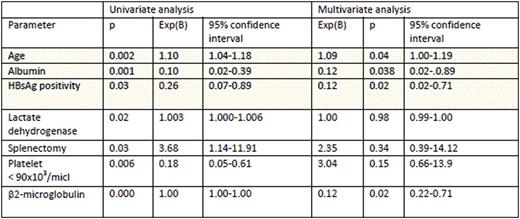Abstract
Splenic marginal zone lymphoma (SMZL) is a rare disease. It constitutes less than 2% of lymphoid neoplasms. Chronic antigenic stimulation is frequently blamed in the pathogenesis of extranodal marginal zone lymphomas including SMZL. Chronic hepatitis C is frequently observed in SMZL patients. However these reports are largely from North America and Europe. Data from various countries with different hepatitis prevalence are lacking.
In this multicenter cohort study we aimed to find out clinical characteristics of SMZL patients in Turkey including viral hepatitis status and treatment details. Data were gathered from voluntary centers under auspices of Hematolojik Onkoloji Dernegi using a SPSS database. Categorical and continuous data were expressed as ratio (%) and median (range) and they were compared by the Chi-square and Mann Whitney U tests, respectively. Survival analyses were computed by the Kaplan-Meier method. Overall survival (OS) was calculated from diagnosis to the date of mortality of any reason. Patients who did not die at last follow-up were censored at this time for OS computations. Parameters related to survival were investigated by Cox regression univariate and multivariate analyses.
66 patients were reported from 8 tertiary care hematology/oncology centers. The diagnosis of SMZL was established by local hematopathologists. Data on baseline clinical characteristics are presented in table 1. Median follow-up duration was 20.4 months (0.3-208) (23 months for surviving patients). 13 patients died during follow-up. Median OS was not reached. Estimated 6 year survival was 59.5% (Figure 1). Older age, no splenectomy during follow-up, <90 x 103 platelet count, lower albumin, higher lactate dehydrogenase, higher b2-microglobulin and HBsAg positivity were associated with increased risk of death. Age, albumin and HBsAg positivity remained significant in multivariate analysis (table 2).
HCV positivity was not observed in any patient in this East Mediterranean/Middle Eastern cohort. However 12.1% HBsAg and 32% HBsAg and/or anti-HBcAg positivities are higher than expected for our population. This finding should be confirmed in a larger cohort. Risk factors associated with worse prognosis were generally similar to those reported in European/North American populations. However, HBsAg positivity has not been reported as a risk factor previously.
Overall survival
Baseline characteristics
Univariate and multivariate analyses for survival
No relevant conflicts of interest to declare.
Author notes
Asterisk with author names denotes non-ASH members.




This feature is available to Subscribers Only
Sign In or Create an Account Close Modal